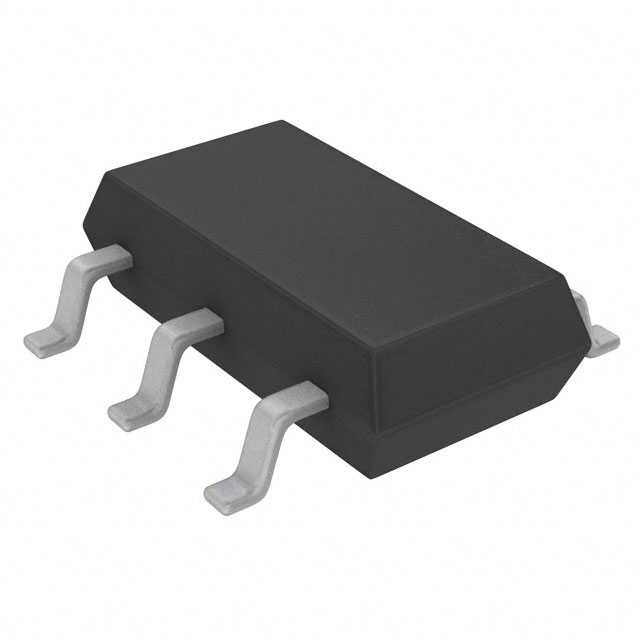LTC4412ES6#TRPBF
Product Overview
Category: Integrated Circuit (IC)
Use: Power Management
Characteristics: - Ideal diode controller - Low voltage drop - Reverse input protection - Overvoltage protection - Undervoltage lockout - Fault flag output - Small package size
Package: SOT-23-6
Essence: The LTC4412ES6#TRPBF is an integrated circuit that functions as an ideal diode controller. It provides low voltage drop and protects against reverse input, overvoltage, and undervoltage conditions. The device also features a fault flag output for easy monitoring.
Packaging/Quantity: The LTC4412ES6#TRPBF is available in a SOT-23-6 package. It is typically sold in reels or tubes containing multiple units.
Specifications
- Input Voltage Range: 2.5V to 5.5V
- Operating Temperature Range: -40°C to 85°C
- Quiescent Current: 20µA
- Maximum Continuous Current: 1A
- Reverse Leakage Current: 10µA
- Fault Flag Output Voltage: 0.4V
- Package Dimensions: 2.9mm x 1.6mm x 1.1mm
Pin Configuration
The LTC4412ES6#TRPBF has the following pin configuration:
```
| | --| IN OUT |-- Pin 1: Input Voltage (IN) --| GND FLT |-- Pin 2: Ground (GND) --| EN FLT |-- Pin 3: Enable (EN) --| FLT FLT |-- Pin 4: Fault Flag Output (FLT) --| GND OUT |-- Pin 5: Ground (GND) --| IN OUT |-- Pin 6: Output Voltage (OUT) |___________| ```
Functional Features
- Ideal diode controller: The LTC4412ES6#TRPBF acts as an ideal diode, allowing current flow in one direction while blocking it in the reverse direction.
- Low voltage drop: The device has a low voltage drop, minimizing power losses.
- Reverse input protection: It protects against reverse polarity connection, preventing damage to the circuit.
- Overvoltage protection: The LTC4412ES6#TRPBF safeguards the load from excessive input voltage.
- Undervoltage lockout: It ensures that the output is disabled when the input voltage falls below a certain threshold.
- Fault flag output: The fault flag pin provides a signal indicating any fault condition.
- Small package size: The SOT-23-6 package offers compactness and ease of integration.
Advantages
- Efficient power management with low voltage drop
- Protection against reverse polarity and overvoltage conditions
- Fault flag output for easy monitoring
- Compact package size allows for space-saving designs
Disadvantages
- Limited maximum continuous current of 1A
- Quiescent current of 20µA may be relatively high for some low-power applications
Working Principles
The LTC4412ES6#TRPBF operates by controlling the gate voltage of an external N-channel MOSFET. When the input voltage is higher than the output voltage, the MOSFET is turned on, allowing current flow. In this state, the LTC4412ES6#TRPBF acts as an ideal diode with a low voltage drop. If the input voltage drops below the output voltage or becomes reverse-polarized, the MOSFET is turned off, blocking current flow and protecting the load.
Application Field Plans
The LTC4412ES6#TRPBF is commonly used in various applications, including:
- Battery-powered devices: It ensures efficient power transfer and protects against reverse battery connection.
- Power supply switching: The device enables seamless switching between multiple power sources, preventing voltage spikes during transitions.
- Automotive electronics: It provides reverse polarity protection and overvoltage protection for automotive circuits.
- Portable electronics: The LTC4412ES6#TRPBF helps optimize power management in portable devices, extending battery life.
Alternative Models
- LTC4412ES6#PBF
- LTC4412ES6#TRMPBF
- LTC4412ES6#TRPBFD
These alternative models offer similar functionality and characteristics to the LTC4412ES6#TRPBF and can be considered as replacements depending on specific requirements.
Word count: 530 words
רשום 10 שאלות ותשובות נפוצות הקשורות ליישום של LTC4412ES6#TRPBF בפתרונות טכניים
Sure! Here are 10 common questions and answers related to the application of LTC4412ES6#TRPBF in technical solutions:
Q: What is LTC4412ES6#TRPBF? A: LTC4412ES6#TRPBF is a power management IC (Integrated Circuit) designed for power path control and protection in various applications.
Q: What are the key features of LTC4412ES6#TRPBF? A: Some key features include reverse input voltage protection, ideal diode functionality, adjustable current limit, and low quiescent current.
Q: How does LTC4412ES6#TRPBF provide reverse input voltage protection? A: The LTC4412ES6#TRPBF utilizes an internal MOSFET to block reverse voltage from reaching the load, protecting it from damage.
Q: Can LTC4412ES6#TRPBF be used as an ideal diode? A: Yes, LTC4412ES6#TRPBF can function as an ideal diode by minimizing voltage drops across the power path, improving efficiency.
Q: Is the current limit adjustable on LTC4412ES6#TRPBF? A: Yes, LTC4412ES6#TRPBF allows users to adjust the current limit to suit their specific application requirements.
Q: What is the typical quiescent current of LTC4412ES6#TRPBF? A: The typical quiescent current of LTC4412ES6#TRPBF is very low, typically in the microampere range, ensuring minimal power consumption.
Q: Can LTC4412ES6#TRPBF handle high currents? A: Yes, LTC4412ES6#TRPBF is designed to handle high currents, making it suitable for applications with demanding power requirements.
Q: What are some common applications of LTC4412ES6#TRPBF? A: LTC4412ES6#TRPBF is commonly used in battery-powered systems, uninterruptible power supplies (UPS), and load sharing applications.
Q: Does LTC4412ES6#TRPBF have built-in protection features? A: Yes, LTC4412ES6#TRPBF provides protection against overcurrent, overvoltage, and reverse voltage conditions, enhancing system reliability.
Q: Is LTC4412ES6#TRPBF available in a surface-mount package? A: Yes, LTC4412ES6#TRPBF is available in a compact SOT-23 package, which is suitable for space-constrained applications.
Please note that the answers provided here are general and may vary depending on the specific application and use case. It's always recommended to refer to the datasheet and consult the manufacturer for detailed information and application-specific guidance.


